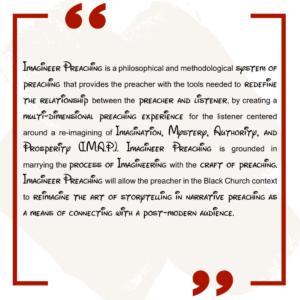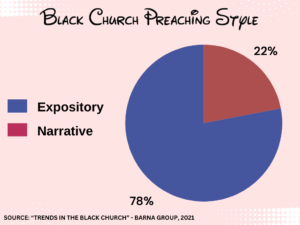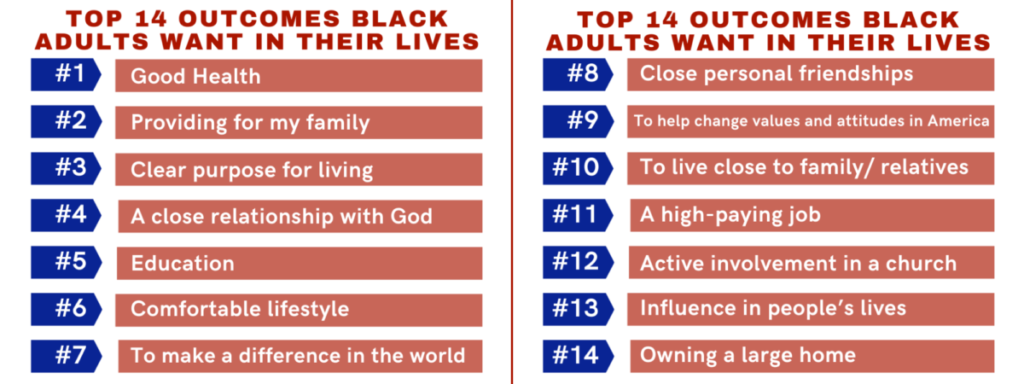THE PROBLEM
Preaching in the Black Church[1] has to be spiritual, hope-filled, creative, immersive, transformative, sustaining, liberating, comforting and defiant. In its best form it is comprised of four elements: God, the Scriptures, the preacher, and Black lived experience.”[2] However, preaching in the Black Church is in the midst of a seismic shift. The following statistics regarding Black adults are telling:
- Identify as Christians: 93% in 2007 to 71% in 2021.[3]
- Identify as “none”: 24%. on par with all Adults.[4]
- The Bible is inerrant: 64% in 2009 to 42% in 2021.[5]
- Read the Bible weekly outside of church: 56% in 2009 to 35% in 2021.[6]
- God is omniscient and omnipotent: Boomers (72%), Gen X (68%), Millennials 55%, and Gen Z 49%.[7]
- Religion is needed for personal fulfillment: 51% agree, 49% disagree.[8]
- Top concern with the Black Church is “Approach to money” – Churchgoers (16%) and the unchurched (30%).[9]
Some of the shifts may be symptomatic of the emergence of a postmodern culture, where skepticism rises and ideas of authority shift from claims of absolute truth and truthful facts to an emphasis on personal experience. People become more persuaded by meaningful experiences than they are by truthful facts.[10]
THE QUESTION
How can a preacher in the evolving Black church context, engage and persuade a growing “unchurched” (def. not attended church in the previous 6 months), post-modern audience that has redefined authority and truth through a lens of personal experience?
THE SOLUTION – IMAGINEER PREACHING
 Walt Disney wanted to expand beyond the two-dimensional confines of his movie storytelling into the three-dimensional world of a theme park. He selected employees from varied areas of his company including story development, visual effects, animation and set-design, to marry their collective expertise into the development of Disneyland.[11] Disney’s process of adapting skills, knowledge, and expertise from one medium and applying them to another became known as “Imagineering,” a combination of the words imagination and engineering.[12]
Walt Disney wanted to expand beyond the two-dimensional confines of his movie storytelling into the three-dimensional world of a theme park. He selected employees from varied areas of his company including story development, visual effects, animation and set-design, to marry their collective expertise into the development of Disneyland.[11] Disney’s process of adapting skills, knowledge, and expertise from one medium and applying them to another became known as “Imagineering,” a combination of the words imagination and engineering.[12]
Imagineer Preaching encourages preachers to embrace, adopt, and blend skills, knowledge and expertise in sermon development from a variety of areas including, theology, literature, audio broadcasting, rhetoric, visual and performing arts, leadership, film, ethics, law and sociology. Imagineer Preaching has four pillars that shape its focus on the post-modern audience.
IMAGINATION – PAINTING THE PICTURE
Sermonic Imagination honed the narrative style of preaching which has been at the heart of Black Preaching for centuries. It placed the Black preacher within the Biblical text to serve as an eyewitness/ tour guide for the congregation. This experiential style, derived from folk sermon traditions, activates the listeners’ five senses and places them within the Biblical text and/or places the Biblical text amongst the listeners.[13] Black churches have seen a shift away from the use of narrative preaching.[14]
 Imagineer Preaching is not saying expository preaching lacks imagination. Instead, Imagineer Preaching is focused on utilizing various forms of Imagination in sermonic storytelling, which may require new readings of a text that move away from “traditional” interpretations and creates room for expanded perspectives.
Imagineer Preaching is not saying expository preaching lacks imagination. Instead, Imagineer Preaching is focused on utilizing various forms of Imagination in sermonic storytelling, which may require new readings of a text that move away from “traditional” interpretations and creates room for expanded perspectives.
 Empathetic and Fearless (Courageous and Persistent) Imagination provide a window into the lives and motivations of individuals in the Biblical text. Just Imagination explores themes of restorative, redemptive and equitable justice. While Aural, Visual and Tactile Imagination paint the picture of the Biblical story. Applying various layers of Imagination into the sermon is integral in developing a multi-dimensional, personally meaningful sermonic experience for the post-modern listener.
Empathetic and Fearless (Courageous and Persistent) Imagination provide a window into the lives and motivations of individuals in the Biblical text. Just Imagination explores themes of restorative, redemptive and equitable justice. While Aural, Visual and Tactile Imagination paint the picture of the Biblical story. Applying various layers of Imagination into the sermon is integral in developing a multi-dimensional, personally meaningful sermonic experience for the post-modern listener.
MYSTERY – EMBRACE THE UNEXPLAINABLE
Imagineer Preaching requires the preacher to embrace the unknown, or perhaps better stated, the unknowable. One of the points of disconnect between the postmodern listener and the preacher is the idea of truth and the place of absolute truth.
In Imagineer Preaching, the phrase “absolute certainty” might be used instead of “absolute truth,” when dealing with points of contention. Why this distinction? Because the Imagineer Preacher leaves room for the possibility that there is another answer, perspective or point of departure. They also acknowledge the possibility of future discovery, new revelations, new hermeneutics, nuanced readings and transformed hearings.
Imagineer Preaching embraces the importance of experience in finding meaning in the Biblical text because just as it’s an element in Black preaching, lived experience is important to postmodern audiences.[15]
AUTHORITY- LEADING DIFFERENTLY
Imagineer Preaching allows the preacher to claim their position of authority not through force, coercion, or manipulation, but as someone who leads the way towards spiritual discovery. The person of the preacher evolves. No longer does the preacher embody the persona of someone who sits above and looks down upon the congregation, but instead is journeying with the congregation. The preacher serves as a guide who keeps the lines of communication and discovery open.
This revised approach to authority works to remove a barrier between the preacher and the post-modern listener, without lessening the efficacy of the Biblical text. The embrace of the process of mystery and discovery provides opportunities for the postmodern listener to find Biblically grounded meaning in their personal experience, whether discovered at the time of hearing the sermon or at a later date based on personal revelation or new experiences.
The impact of the shift of authority may not be felt in the individual sermonic moments, but moreso in the development of a trusting relationship between the preacher and postmodern listener: the guide and the seeker.
PROSPERITY – BEYOND WEALTH
Imagineer Preaching believes the concept of “prosperity” is worth reclaiming in preaching because it speaks to the variety of ways a person can experience human flourishing. There are a cadre of life outcomes which Black Adults find vitally important and expanding the definition of prosperity beyond wealth accumulation would allow the preacher to meet both Black Church Churchgoers and the Unchurched at their desire to find meaning in life.[16]
In her book Colored Television, Marla Frederick provides three definitions of prosperity that reimagine what motivates people towards finding meaning.[17]
- Constitutionally Relative – Peace of mind, joy, family harmony and growth, a relationship with God, and good marital relationships.[18]
- Temporally Relative – Based on an individual’s past, present or future circumstances.[19]
- Spatially Relative – Within a community, city, country or other geography.[20]
Imagineer Preaching believes whether constitutional, temporal, or spatial, each category of prosperity speaks to a form of human flourishing/ prosperity that has the ability to reach each person, in every seat, in the same sermon.
CONCLUDING THOUGHTS
Imagineer Preaching will assist preachers in harnessing imagination to create memorable, multi-dimensional sermonic experiences that draw post-modern listeners closer to Christ by reorienting their relationship with authority, redefining prosperity and embracing spiritual mystery.
 Rev. Elliott S. Robinson, JD
Rev. Elliott S. Robinson, JD
Creator of Imagineer Preaching
Rev. Elliott S. Robinson, JD on LinkedIn
RESOURCES
- Frederick, Marla Faye. Colored Television : American Religion Gone Global. Stanford, California: Stanford University Press, 2015.
- Imagineers (Group), and Walt Disney Company, eds. Walt Disney Imagineering: A behind the Dreams Look at Making the Magic Real. 1st ed. New York: Hyperion, 1996.
- LaRue, Cleophus James. I Believe I’ll Testify: The Art of African American Preaching. Louisville, Ky: Westminster John Knox Press, 2011.
- Thomas, Frank A. Introduction to the Practice of African American Preaching. Nashville: Abingdon Press, 2016.
- “Trends in the Black Church – Celebrating Its Legacy and Investing in a Hopeful Future.” Dallas-Ft. Worth, TX: Barna Group, 2021.
FOOTNOTES
[1] African Methodist Episcopal, African Methodist Episcopal Zion, The Christian Methodist Episcopal, Church of God in Christ, National Missionary Baptist Church of America, National Baptist Convention of America, Progressive National Baptist Convention n.d.
[2] Cleophus James LaRue, I Believe I’ll Testify: The Art of African American Preaching (Louisville, Ky: Westminster John Knox Press, 2011), 58.
[3] “Trends in the Black Church – Celebrating Its Legacy and Investing in a Hopeful Future” (Dallas-Ft. Worth, TX: Barna Group, 2021), 24.
[4] “Trends in the Black Church – Celebrating Its Legacy and Investing in a Hopeful Future,” 22, 24 None: atheist, agnostic or no faith.
[5] “Trends in the Black Church – Celebrating Its Legacy and Investing in a Hopeful Future,” 30.
[6] “Trends in the Black Church – Celebrating Its Legacy and Investing in a Hopeful Future,” 24.
[7] “Trends in the Black Church – Celebrating Its Legacy and Investing in a Hopeful Future,” 27.
[8] “Trends in the Black Church – Celebrating Its Legacy and Investing in a Hopeful Future,” 22.
[9] “Trends in the Black Church – Celebrating Its Legacy and Investing in a Hopeful Future,” 47.
[10] O. Wesley Allen and Carrie La Ferle, Preaching and the Thirty-Second Commercial: Lessons from Advertising for the Pulpit, First edition (Louisville, Kentucky: Westminster John Knox Press, 2021), 3.
[11] Imagineers (Group) and Walt Disney Company, eds., Walt Disney Imagineering: A behind the Dreams Look at Making the Magic Real, 1st ed (New York: Hyperion, 1996), 11.
[12] Louis J. Prosperi and Jeffrey A. Barnes, The Imagineering Pyramid: Using Disney Theme Park Design Principles to Develop and Promote Your Creative Ideas, ed. Bob McLain (Theme Park Press, 2016), 6.
[13] Frank A. Thomas, Introduction to the Practice of African American Preaching (Nashville: Abingdon Press, 2016), 87.
[14] “Trends in the Black Church – Celebrating Its Legacy and Investing in a Hopeful Future,” 106.
[15] LaRue, I Believe I’ll Testify, 58.
[16] “Trends in the Black Church – Celebrating Its Legacy and Investing in a Hopeful Future,” 64.
[17] Marla Faye Frederick, Colored Television : American Religion Gone Global (Stanford, California: Stanford University Press, 2015), 61–85.
[18] Frederick, 71.
[19] Frederick, 71–72, 80.
[20] Frederick, 72.

